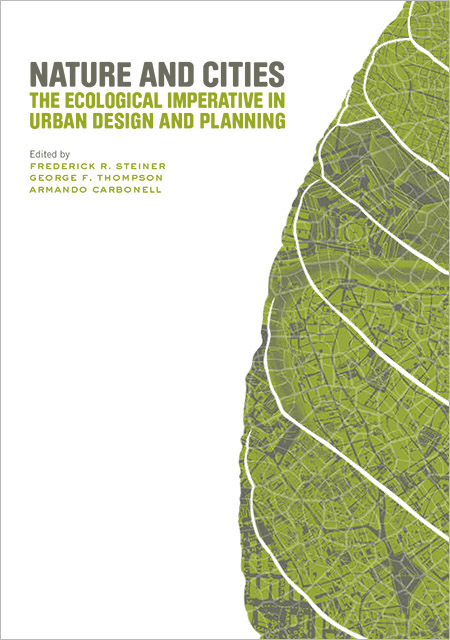Frederick R. Steiner, Georg F. Thompson, Armando Carbonell
Lincoln Institute of Land Policy, 2016

In 1997 George Thompson and Frederick Steiner edited a volume of essays entitled Ecological Design and Planning with the intent of resolving the divide between art and science that had plagued the professions of landscape architecture and land planning following the success of Ian McHarg’s Design with Nature (1969) and the implementation of his brand of ecological design.1 To address the situation, the text included essays that ranged from McHarg’s defense of ecological design to Elizabeth Meyer’s feminist critique of ecological determinism in which she argued the following oppositions were in dire need of a transformational synthesis and operative re-coding:
Aesthetics and science. Art and science. Art and ecology. Culture and nature. Architecture and landscape. City and country. Public and private. Reason and emotion. Male and female. Man and woman. Man and nature.2
In 2016 Thompson and Steiner, with the assistance of Armando Carbonell, returned to the issue of ecology and design. Confident that landscape architecture and land planning had in the intervening years moved beyond dualities and fully integrated art and science into their practices, they turned their attention to cities and the environmental and social problems engendered by their rapid growth. Accordingly, this edited volume, entitled Nature and Cities: The Ecological Imperative in Urban Design and Planning, explores contemporary urban design and the challenges landscape architects and land planners face as they seek to define new ways to make cities more livable, environmentally sustainable, and ecologically resilient. The resulting compendium provides a range of ideas and opinions rather than an exhaustive summary of current practice. To be fully appreciated, the essays in Nature and Cities need to be seen in relationship to Ecological Design and Planning.
As one might expect from a critical survey on the imperatives of ecological design, all of the essays in Nature and Cities, in their various pronouncements about urbanism, ecology, sustainability, adaptation, and resiliency, frame the subject of landscape design and planning around the land itself and the way it is perceived and shaped. This begins with the following declarative sentence: “The land tells us so much” (xviii. These six words not only capture the essence of this richly illustrated text, they also proclaim that its content should be read as a manifesto and a critical narrative history.
Highlights of the text include Richard Weller’s historical recap of the scientific ideas underlying landscape urbanism, Elizabeth Meyer’s exploration of landscape aesthetics, Carol Franklin’s continuing allegiance to McHarg and her insightful materializations of his ideas, Danilo Palazzo’s utopian history of the profession and its progressive vision of the good life, Nina Marie Lister’s lucid presentation of ecological thinking and its shift from balance to resiliency, Kristina Hill’s call for expanded compassion in the wake of environmental disasters, Kate Orff’s commitment to the accumulative agency of small-scale design interventions, and Kongjian Yu’s attention to land stewardship in the agricultural landscapes of China. Less inspiring are the essays by James Corner, Laurie Olin, and Anne Whiston Spirn, which read as perfunctory recitations of accomplishments. In tone and content, these latter essays fall short of the level of insightful critique that exemplified the authors’ earlier writings. In a similar manner, the discussion of ecological design by Chris Reed that immediately follows the more in-depth exploration provided by Nina Marie Lister seems redundant.
The authors selected to contribute essays for Nature and Cities are well-known theorists and practitioners who either teach at elite educational institutions or head prestigious design firms. This is the book’s greatest strength—the essays illustrate the insightful contributions these institutions and firms have made in shaping the way the professions of landscape architecture and urban planning perceive the land and materialize their ideas—and its greatest weakness—the essays promulgate a select and somewhat privileged way of seeing, analyzing, and designing the land that inadvertently imposes conceptual limits upon the discussion.
The important point here is that cities face many problems, most of which are of our own making, and Nature and Cities illustrates there are powerful reasons to promote ecological design as a means to address these issues. Ecological design does work, and the essays in this book teach us how it works. They do so by demonstrating how this practice, at its best, constructs a pact with nature that is grounded in environmental welfare and built on equity. In these contentious times, this way of seeing and sharing is more important than ever. This message needs to reach a wider audience, and this requires an even wider world of ideologies and experiences than what is presented in Nature and Cities. Indeed, to remain relevant, the professions of landscape architecture and land planning must expand their core repertoire to include a more diverse coterie of authors, opinions, practices, and projects that chronicle the ecology of urban design in developing as well as developed countries. This imperative will be unavoidable as these design disciplines continue to confront the challenges posed by a world of burgeoning populations and crowded cities, where people are displaced by rising water, and the basic necessities of shelter and food are increasingly compromised.
Despite this, Nature and Cities, in keeping with the editors’ life-long commitment to ecology and environmental design, provides a thoughtful and optimistic summary of the topic in contemporary design discourse. The essays are an essential read for anyone interested in the history, theory, and practice of landscape architecture, and, similar to those produced for Ecological Planning and Design, no doubt will become a staple of academic training.
How to Cite this Article: Alder, John. Review of Nature and Cities: The Ecological Imperative in Urban Design and Planning, by Frederick R. Steiner, Georg F. Thompson, and Armando Carbonell. JAE Online. November 8, 2017.






